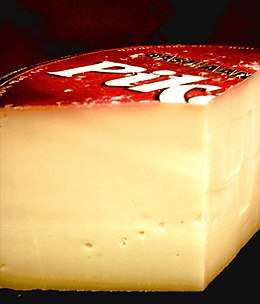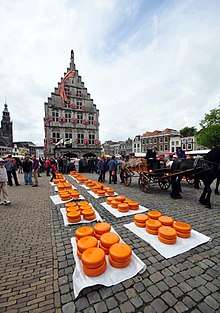Gouda cheese
| Gouda | |
|---|---|
 | |
| Country of origin | Netherlands |
| Region | South Holland |
| Town | Gouda |
| Source of milk | Cows |
| Pasteurised | Possibly |
| Texture | Semi-hard to Hard |
| Aging time | 1–36 months |
| Named after | Gouda |
|
| |
Gouda (English: /ˈɡaʊdə/ (![]()
![]()
![]()
History

The first mention of Gouda cheese dates from 1184, making it one of the oldest recorded cheeses in the world still made today.[3]
Cheesemaking traditionally was a woman's task in Dutch culture, with farmers' wives passing their cheesemaking skills on to their daughters.
The cheese is named after the city of Gouda not because it was produced in or around that city, but because it was traded there.[4] In the Middle Ages, Dutch cities could obtain certain feudal rights which gave them primacy or a total monopoly on certain goods. Within the County of Holland, Gouda acquired market rights on cheese, the sole right to have a market in which the county's farmers could sell their cheese. All the cheeses would be taken to the market square in Gouda to be sold. Teams consisting of the guild of cheese-porters, identified by differently colored straw hats, carried the farmers' cheeses on barrows, which typically weighed about 16 kg. Buyers then sampled the cheeses and negotiated a price using a ritual system called handjeklap in which buyers and sellers clap each other's hands and shout prices. Once a price was agreed upon, the porters would carry the cheese to the weighing house and complete the sale.[5]
To this day, farmers from the surrounding region gather in Gouda every Thursday morning between 10:00 am and 12:30 pm from June until August to have their cheeses weighed, tasted, and priced. Most Dutch Gouda is now produced industrially. However, some 300 Dutch farmers still produce boerenkaas (“farmers cheese”) which is a protected form of Gouda made in the traditional manner, using unpasteurized milk.
Process

Various sources suggest that the term "Gouda" refers more to a general style of cheesemaking rather than to a specific kind of cheese, pointing to its taste varying with age.[6] Young (and factory-produced) gouda has been described as having a flavor that is "lightly fudgy with nuts, but very, very, very mild", while the same source describes a more mature farmhouse Gouda as having a "lovely fruity tang" with a "sweet finish", that may take on "an almost butterscotch flavor" if aged over two years.[7]
After cultured milk is curdled, some of the whey is then drained and water is added. This is called "washing the curd", and creates a sweeter cheese, as the washing removes some of the lactose, resulting in a reduction of lactic acid produced.[8] About 10% of the mixture is curds, which are pressed into circular molds for several hours. These molds are the essential reason behind its traditional, characteristic shape. The cheese is then soaked in a brine solution, which gives the cheese and its rind a distinctive taste.[9]
The cheese is dried for a few days before being coated with a yellow coating to prevent it from drying out, then it is aged, during which process the cheese changes from semihard to hard. Dutch cheesemakers generally use six gradations to classify the cheese:
- Young cheese (4 weeks)
- Young matured (8–10 weeks)
- Matured (16–18 weeks)
- Extra matured (7–8 months)
- Old cheese (10–12 months)
- Very old cheese (12 months and more)
As it ages, it develops a caramel sweetness and has a slight crunchiness from cheese crystals, especially in older cheeses. In the Netherlands, cubes of gouda are often eaten as a snack served with Dutch mustard. Older varieties are sometimes topped with sugar or apple syrup. Cubes of old and very old gouda are eaten alongside strong beers or with port wine.
Reypenaer
Reypenaer is a Gouda cheese that is hand-made by the Van den Wijngaard family. This cheese is ripened in a historic cheese warehouse at Utrechtsestraatweg 19 in Woerden, which is a national monument.[10] The warehouse has no air-conditioning; humidity and temperature – and thereby the ripening of the cheese – are controlled by the cheese master who opens and closes the building's windows and shutters.[11] The cheese is made from milk produced by grass-fed cows and turned by hand weekly during the ripening process.[12]
Protection
The term "Gouda" is not restricted to cheese of Dutch origin.[13] However, "Boerenkaas", "Noord-Hollandse Gouda", and "Gouda Holland" are registered in the EU as having Protected Geographical Indication status.[14][15] These cheeses can only be made in the Netherlands (although not only in the Dutch provinces of South-Holland, in which Gouda is situated) and can only use milk produced by Dutch cows.[16][17]
See also
References
- ↑ "Gouda | a mild cheese of Dutch origin that is similar to Edam, but contains more fat". www.merriam-webster.com. Retrieved 2015-11-07.
- ↑ "European commission confirms protection for Gouda Holland". DutchNews.NL. 7 October 2010. Retrieved October 7, 2010.
- ↑ "Geschichte des Käses". de:Centrale Marketing-Gesellschaft der deutschen Agrarwirtschaft mbH (CMA). Archived from the original on 2006-06-13.
- ↑ "Gouda | cheese". Encyclopedia Britannica. Retrieved 2018-06-07.
- ↑ Alkmaar cheese market - Cheese Bargaining. kaasmarkt.nl; nl:Vereniging voor Vreemdelingenverkeer (VVV), NL.
- ↑ "Gouda". Cheese.com. Retrieved 14 August 2014.
- ↑ Ridgway, Judy (2002). The Cheese Companion: The Connoisseur's Guide (2nd ed.). Apple. p. 103. ISBN 1840923393. Retrieved 9 December 2017.
- ↑ "Gouda: Making the Cheese". New England Cheesemaking Supply Company. Retrieved 14 August 2014.
- ↑ "Frisian Farms Small Batch Gouda: Our Process". Archived from the original on 1 March 2015. Retrieved 14 August 2014.
- ↑ Reypenaer. "De Wijngaard Kaas familie - Reypenaer - Historisch gerijpte kaas uit Woerden". www.reypenaer.nl (in Dutch). Retrieved 2018-03-15.
- ↑ "Reypenaer: de smaak van tijd - Sligro.nl". www.sligro.nl (in Dutch). Retrieved 2018-03-15.
- ↑ Reypenaer. "The craftsmanship - Reypenaer - Historical ripened Dutch cheeses of Woerden". www.reypenaer.nl. Retrieved 2018-03-15.
- ↑ "Kwaliteit Goudse kaas brokkelt af". Nieuwsblad.be (in Dutch). Brussels. Retrieved 2007-12-11.
- ↑ "COMMISSION REGULATION (EU) No 1122/2010 of 2 December 2010 - entering a designation in the register of protected designations of origin and protected geographical indications (Gouda Holland (PGI))". Official Journal of the European Union.
- ↑ "Noord-Hollandse Gouda". Agriculture Quality Policy. European Commission. Archived from the original on 2008-03-03. Retrieved 2007-12-11.
- ↑ "Gouda Holland, Edam Holland to get protected status". DutchNews.nl. 2010-09-14. Retrieved 2013-11-14.
- ↑ "Dutch cheeses Edam Holland and Gouda Holland granted protected status | Press release". Government.nl. 2010-10-08. Retrieved 2013-11-14.
External links
| Wikimedia Commons has media related to Gouda cheese. |
| Look up gouda in Wiktionary, the free dictionary. |